World War I
In November 1915, the Monte Cervino Alpini Battalion was raised in the village of Ivrea in northern Italy. Initially only fielding a single Alpini company (133rd Alpini Company "La nobile tonante"), it was augmented quickly by the 87th and 103rd Alpini Companies, which were reserve companies of the Aosta Alpini Battalion of the same regiment. After a short training regime in the village of Tirano, the battalion was sent in April 1916 to the Asiago plateau to reinforce the front, arriving just in time to feel the full brunt of the Austrian "Strafexpedition" offensive on the Asiago Plateau. After fierce fighting on May 15, the 103rd Company was overcome and had to surrender the Borcola Pass to the advancing Austrians. The 87th and 133rd Companies were able to withdraw from the advancing Austrians. With the commencement of the Italian counter-offensive, the remaining soldiers of the Monte Cervino fought in the Caldiera e Posina valleys.

Ivrea is a town and comune of the Metropolitan City of Turin in the Piedmont region of northwestern Italy. Situated on the road leading to the Aosta Valley, it straddles the Dora Baltea and is regarded as the centre of the Canavese area. Ivrea lies in a basin that in prehistoric times formed a large lake. Today five smaller lakes — Sirio, San Michele, Pistono, Nero and Campagna — are found in the area around the town.

Tirano is a town in Valtellina, located in the province of Sondrio in northern Italy. It has 9,053 inhabitants (2016) and is adjacent to the Switzerland-Italy boundary. The river Adda flows through the town.

Asiago is the name of both a major Italian Protected Designation of Origin (PDO,) as well as a cheese, and a minor township in the surrounding plateau region in the Province of Vicenza in the Veneto region of Northeastern Italy. It is near the border between the Veneto and Trentino-Alto Adige/Südtirol regions in the foothills of the Alps, and about equidistant (60 km) from the major cities of Trento to the west and Vicenza to the south. The Asiago region is the origin of Asiago cheese. The town was the site of a major battle between Austrian and Italian forces on the Alpine Front of World War I. It is a major ski resort destination as well as the site of the Astrophysical Observatory of Asiago, operated by the University of Padua.
In 1917, the battalion was employed on the Isonzo Front in a futile attempt to take Monte Vodice. In November of the same year, the battalion was tasked to defend the Melette di Gallio on the Asiago plateau against a renewed Austrian attack on the Asiago plateau. Afterwards, it was sent to the rear to rest and refit. In June 1918, the battalion defended the Monte Fior and Monte Castelgomberto mountains against the last Austrian attempt to break through the Italian lines on the Asiago plateau and thus open up a way into the Padan plain. Thirty officers and 1,000 Alpinis of the battalion died during the defence of Monte Fior - 2/3 of the unit's men at the onset of the Austrian offensive. For this sacrifice, the battalion was awarded Italy's second highest military order: the Silver Medal of Military Valor.

The Po Valley, Po Plain, Plain of the Po, or Padan Plain is a major geographical feature of Northern Italy. It extends approximately 650 km (400 mi) in an east-west direction, with an area of 46,000 square kilometres (18,000 sq mi) including its Venetic extension not actually related to the Po river basin; it runs from the Western Alps to the Adriatic Sea. The flatlands of Veneto and Friuli are often considered apart since they do not drain into the Po, but they effectively combine into an unbroken plain.
The Silver Medal of Military Valor is an Italian medal for gallantry.
After being augmented with new recruits, the battalion spent the last months of the war on Monte Pasubio and later Monte Grappa. With the cessation of hostilities, the battalion was dissolved in 1919.
World War II
The battalion was reformed in 1940 as the Monte Cervino Ski-battalion ("Battaglione Sciatori Monte Cervino"), with the 1st and 2nd Ski Companies, and was sent as reinforcement to the crumbling Italian front on the Albanian border with Greece. After the German invasion of Greece and subsequent cessation of hostilities, the battalion was dissolved in May 1941. For the successful operations in the Greek theatre, the battalion was awarded Italy's highest military order: the Gold Medal of Military Valor.

The Greco-Italian War took place between the kingdoms of Italy and Greece from 28 October 1940 to 23 April 1941. This local war began the Balkans Campaign of World War II between the Axis powers and the Allies. It turned into the Battle of Greece when British and German ground forces intervened early in 1941.

The Battle of Greece is the common name for the invasion of Allied Greece by Fascist Italy and Nazi Germany in April 1941 during World War II. The Italian invasion in October 1940, which is usually known as the Greco-Italian War, was followed by the German invasion in April 1941. German landings on the island of Crete came after Allied forces had been defeated in mainland Greece. These battles were part of the greater Balkan Campaign of Germany.
Five months later, the battalion was again reformed, and with two ski companies and the 80th Support Weapons Company, was sent to the Soviet Union as part of the Italian Army in Russia. There, the battalion distinguished itself in heavy combat with Soviet forces in the Italian campaign on the Eastern Front, barely escaping annihilation in the Battle of Nikolayevka. After its return to Italy in spring of 1943, the battalion was awarded its second Gold Medal of Military Valor. The battalion was then assigned to the XX Alpini Skier Group, but did not participate in combat. The battalion surrendered to German forces in France in September 1943 after the Armistice between Italy and Allied armed forces.

The Soviet Union, officially the Union of Soviet Socialist Republics (USSR), was a socialist state in Eurasia that existed from 1922 to 1991. Nominally a union of multiple national Soviet republics, its government and economy were highly centralized. The country was a one-party state, governed by the Communist Party with Moscow as its capital in its largest republic, the Russian Soviet Federative Socialist Republic. Other major urban centres were Leningrad, Kiev, Minsk, Alma-Ata, and Novosibirsk. It spanned over 10,000 kilometres east to west across 11 time zones, and over 7,200 kilometres north to south. It had five climate zones: tundra, taiga, steppes, desert and mountains.

The Italian Army in Russia was an army-sized unit of the Italian Royal Army which fought on the Eastern Front during World War II. The ARMIR was also known as the 8th Italian Army and initially had 235,000 soldiers.
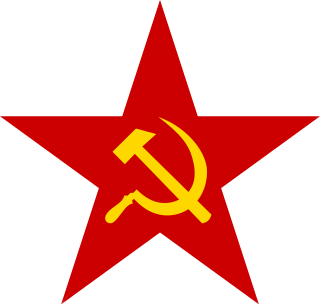
The Workers' and Peasants' Red Army, frequently shortened to Red Army was the army and the air force of the Russian Soviet Federative Socialist Republic, and, after 1922, the Union of Soviet Socialist Republics. The army was established immediately after the 1917 October Revolution. The Bolsheviks raised an army to oppose the military confederations of their adversaries during the Russian Civil War. Beginning in February 1946, the Red Army, along with the Soviet Navy, embodied the main component of the Soviet Armed Forces; taking the official name of "Soviet Army", until its dissolution in December 1991.
The Cold War
During the Cold War, the IV Alpine Army Corps in Bolzano raised an Alpini Parachutist Platoon in all five of its brigades. The first to become active was the platoon of the Alpine Brigade Tridentina, which officially was added to the brigade's unit roll on September 1, 1952. That platoon was quickly followed by platoons raised in the Alpine Brigade Julia, Alpine Brigade Taurinense, Alpine Brigade Cadore and Alpine Brigade Orobica. On April 1, 1964, the five platoons were merged into an Alpini Parachutist Company (COMPALPAR), under the direct command of the IV Alpine Army Corps. On January 1, 1990, the company received the name Monte Cervino and became the heir to the battalion's colours and traditions. In 1993, the company was sent to Mozambique as part of the Italian contribution to the United Nations Operation in Mozambique.
On July 14, 1996, the Alpini Parachutist Company Monte Cervino became the first company of the reformed Alpini Parachutist Battalion Monte Cervino, which quickly augmented its personnel by adding a second Alpini Parachutist Company. From 1997 onwards, the battalion was employed in Bosnia as part of SFOR. Beginning in 2002, the battalion was constantly present with at least a company of troops in Afghanistan as part of the International Security Assistance Force.

The 2nd Alpini Regiment is a light Infantry regiment of the Italian Army, specializing in mountain combat. The Alpini are a mountain infantry corps of the Italian Army, that distinguished itself in combat during World War I and World War II. The regiment was disbanded in 1943 due to losses on the Eastern Front, however one of its component battalions, the Saluzzo Battalion, was reformed in November 1945 after the end of hostilities in Europe. The regiment itself was reformed in 1963 as a training unit, however, following a restructuring of the Italian Army in 1974 it was disbanded once again. In 1992 the regiment was raised once again and today it consists of only the Saluzzo Battalion, based at Borgo San Dalmazzo as part of the Taurinense Brigade.

The 3rd Alpini Regiment is a light Infantry regiment of the Italian Army, specializing in mountain combat. The Alpini are a mountain infantry corps of the Italian Army, that distinguished itself in combat during World War I and World War II.
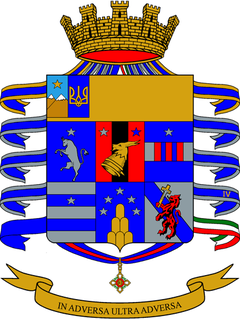
The 4th Alpini Paratroopers Regiment is a Ranger type infantry regiment of the Italian Army, specializing in mountain combat. The Alpini are a mountain infantry corps of the Italian Army, that distinguished itself in combat during World War I and World War II. Today the 4th Alpini Regiment is one of the army's special forces specialized in the airborne assault role. The 4th Alpini Regiment is one of the most decorated regiments of the Italian Army, although its two Gold Medals of Military Valour were awarded to the regiment's Alpini Battalion Aosta, and Alpini Skiers Battalion Monte Cervino.

The 5th Alpini Regiment is a light infantry regiment of the Italian Army, specializing in Mountain Combat. The Alpini are a mountain infantry corps of the Italian Army, that distinguished itself in combat during World War I and World War II.

The Alpini Brigade Cadore was a light Infantry brigade of the Italian Army, specializing in mountain warfare. Its core units were the Alpini, the mountain infantry corps of the Italian Army, that distinguished itself in combat during World War I and World War II. The brigade was based in the Italian provinces of Belluno and Vicenza. The headquarters was in the city of Belluno. It was disbanded in 1997.

The Alpini Brigade Julia is a light Infantry brigade of the Italian Army, specializing in Mountain Combat. Its core units are the Alpini, the mountain infantry corps of the Italian Army, that distinguished itself in combat during World War I and World War II. The Brigade carries on the name and traditions of the 3rd Alpine Division Julia. The division's and brigade's name alludes to the Julian Alps in the Friuli region where the division's regiments recruited their troops from, and where after World War II the brigade was based. Accordingly the brigade's coat of arms is modeled after the Friuli region's coat of arms.
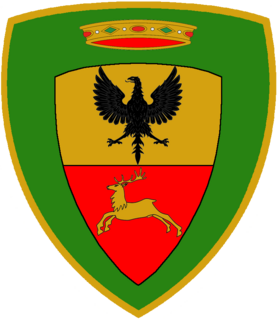
The Alpine Brigade Orobica was a light Infantry brigade of the Italian Army, specializing in mountain warfare. Its core units were the Alpini, the mountain infantry corps of the Italian Army, that distinguished itself in combat during World War I and World War II.

The Alpine Brigade Taurinense is a light Infantry brigade of the Italian Army, specializing in Mountain Combat. Its core units are the Alpini, the mountain infantry corps of the Italian Army, that distinguished itself in combat during World War I and World War II. The brigade’s name Taurinense alludes to the Roman name Augusta Taurinorum for the city of Turin around which the brigade is based. The Brigade carries on the name and traditions of the 1st Alpine Division Taurinense and its coat of arms is modeled after Turin's coat of arms.

The Alpini Brigade Tridentina was a light Infantry brigade of the Italian Army, specializing in mountain warfare. Its core units were the Alpini, the mountain infantry corps of the Italian Army, that distinguished itself in combat during World War I and World War II. The Tridentina Alpine Brigade carried on the colours and traditions of the WWII era 2nd Alpine Division Tridentina.

The 6th Alpini Regiment is a light infantry training regiment of the Italian Army, specializing in mountain warfare. The Alpini are a mountain infantry corps of the Italian Army, that distinguished itself in combat during World War I and World War II.

The 7th Alpini Regiment is a light Infantry regiment of the Italian Army, specializing in mountain combat. The Alpini are a mountain infantry corps of the Italian Army, that distinguished itself in combat during World War I and World War II.
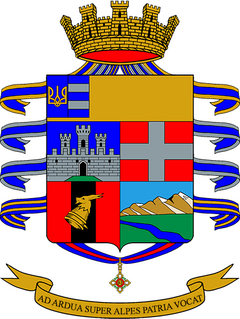
The 9th Alpini Regiment is a light Infantry regiment of the Italian Army, specializing in Mountain Combat. The Alpini are a mountain infantry corps of the Italian Army, that distinguished itself in combat during World War II.

The 11th Alpini Regiment was a light Infantry regiment of the Italian Army, specializing in Mountain Combat. The Alpini are a mountain infantry corps of the Italian Army, that distinguished itself in combat during World War I and World War II.

The Paratroopers Brigade "Folgore" is an airborne brigade of the Italian Army. Its core units are three battalions of paratroopers (paracadutisti). The name Folgore is Italian for lightning. The Folgore is one of three light infantry brigades of the Italian Army. While the Folgore specializes in parachute operations its sister brigade in the Friuli Division the Airmobile Brigade Friuli specializes in helicopter assault operations. The Folgore and its units are based in Tuscany, Veneto and Lazio.

The Comando Truppe Alpine or COMTA commands the Mountain Troops of the Italian Army, called Alpini and various support and training units. It is the successor to the 4º Corpo d'Armata Alpino of the Cold War. The Alpini are light Infantry units specializing in Mountain Combat. The subordinate units of the COMTA distinguished themselves during combat in World War I and World War II.
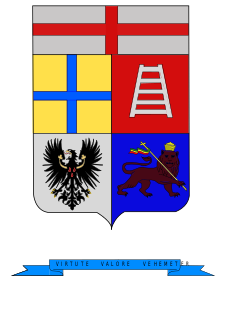
The 3rd Army Corps was one of three corps the Italian Army fielded during the Cold War. Based in the regions of Lombardy and Piemont the corps was the army's operational reserve, while the 4th Alpine Army Corps and the 5th Army Corps, both based in the North East of Italy, were the army's front-line units. After the end of the Cold War the corps was reduced in size and on 1 December 2000 it ceded its last brigades to the 1st Defence Forces Command. The personnel of the 3rd Army Corps was used to raise the NATO Rapid Deployable Italian Corps in January 2001.
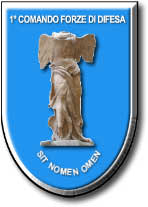
The 5th Army Corps was one of three corps the Italian Army fielded during the Cold War. Based in the regions of Veneto and Friuli-Venezia-Giulia the corps was the army's main combat force. The 5th Army Corps was arrayed close to the Yugoslavian border and tasked with meeting any Warsaw Pact forces that crossed the border. On the left flank of the corps the 4th Alpine Army Corps was tasked with blocking the Alpine passes and in the rear of the corps the 3rd Army Corps served as operational reserve. After the end of the Cold War the corps was reduced in size and on 1 October 1997 it became the 1st Defence Forces Command. In 2013 the COMFOD 1° was disbanded and its function and brigades taken over by the 20th Infantry Division Friuli in Florence.

The Alpini are a specialised mountain warfare infantry corps of the Italian Army, which distinguished itself in World War I fighting in the Alps against Austro-Hungarian Kaiserjäger and the German Alpenkorps. The Alpini were supported by the Mountain Artillery, which both share the Cappello Alpino as identifying symbol. Below follow tables listing the regiments, battalions and groups, companies and batteries of the Alpini and Mountain Artillery active in World War I.




























